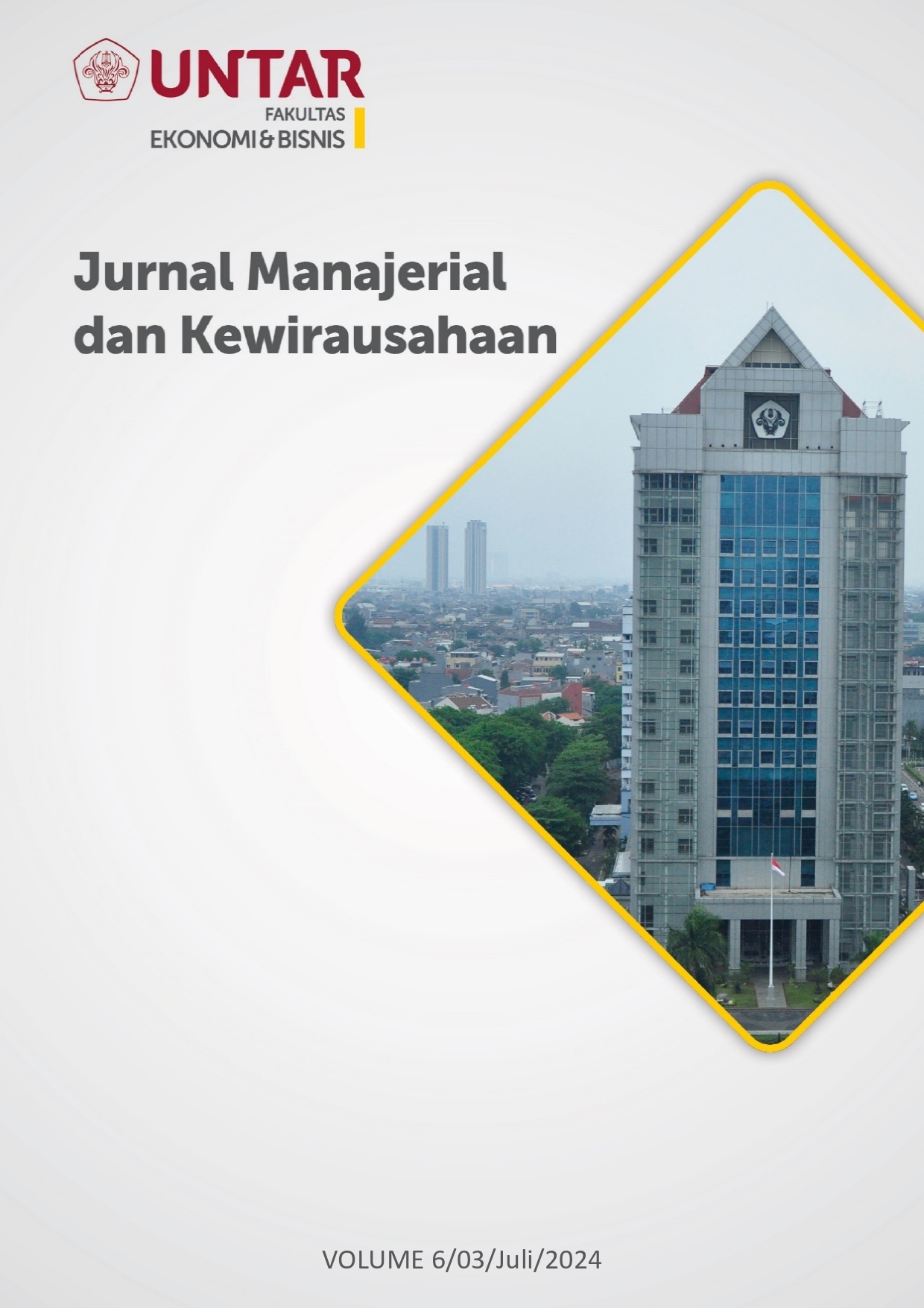Pengaruh Kepuasan Pelanggan sebagai Mediator Antara Ekuitas Merek dan Loyalitas Merek Apple
Main Article Content
Abstract
The rapid development of technology has changed people's lifestyles to be all online. Consumers can easily search for information, and buy products online, thus creating intense competition for entrepreneurs. brand loyalty is an important key for entrepreneurs to increase profits maintain market share and compete with competitors. This study aims to determine the effect of brand equity dimensions, namely perceived quality, perceived value of cost, brand identification, trust, and lifestyle compatibility on brand loyalty with customer satisfaction as a mediator for segments on high involvement products, especially on smartphones with the Apple brand in Jakarta. The method used in this research is a descriptive quantitative method by distributing questionnaires online via Google Forms to 161 respondents in Jakarta using the smartPLS 4 tool. The results showed that there was no effect on perceived quality and brand identification on customer satisfaction on Apple brand smartphones. However, the perceived value of cost, brand trust, and lifestyle fit positively and significantly affect customer satisfaction. In addition, customer satisfaction positively and significantly affects brand loyalty on the perceived value of cost, trust, and lifestyle fit. Thus it can be concluded that in products with high involvement, especially in smartphones, satisfaction and brand loyalty cannot continue to rely on perceptions and brand identification alone. but there are other factors to maintain brand loyalty and get customer satisfaction.
Article Details
Section

This work is licensed under a Creative Commons Attribution-NonCommercial-ShareAlike 4.0 International License.
This work is licensed under a Jurnal Muara Ilmu Ekonomi dan Bisnis Creative Commons Attribution-ShareAlike 4.0 International License.,/p>
References
Aaker, D. A. (1991). Managing Brand Equity: Capitalizing on the Value of A Brand Name. New York: The Free Press.
Aaker, D. A. (1996). Building Strong Brands. New York: The Free Press.
Aaker, D. A. (2004). Brand Portfolio Strategy. New York: The Free Press.
Amani, D. (2023). The mediation role of perceived brand trustworthiness in brand social responsibility and brand positioning: Evidence from the tanzanian beverage industry. European Journal of Management Studies, 28(3), 213-227. https://doi.org/10.1108/ejms-09-2022-0059
Bailey, S., & Milligan, A. (2023). Myths of branding: Dispel the misconceptions and become a brand expert. Kogan Page Publishers.
Chaudhuri, A., & Holbrook, M. B. (2001). The chain of effects from brand trust and brand affect to brand performance: The role of brand loyalty. Journal of Marketing, 65(2), 81-93. https://doi.org/10.1509/jmkg.65.2.81.18255
Fenetta, A. & Keni, K. (2020). Pengaruh Brand Awareness dan Perceived Quality terhadap Purchase Intention: Brand Loyalty sebagai Variabel Mediasi. Jurnal Manajemen Bisnis dan Kewirausahaan, 4(6), 270-275. https://doi.org/10.24912/jmbk.v4i6.9792
Hair, J. F., Black, W. C., Babin, B. J., & Anderson, R. E. (2019). Multivariate data analysis (8th ed.). Cengage Learning EMEA.
Johnson, M. D., Herrmann, A., & Huber, F. (2006). The evolution of loyalty intentions. Journal of Marketing, 70(2), 122-132. https://doi.org/10.1509/jmkg.70.2.122
Kataria, S., & Saini, V. (2019). The mediating impact of customer satisfaction in relation of brand equity and brand loyalty. South Asian Journal of Business Studies, 9(1), 62-87. https://doi.org/10.1108/sajbs-03-2019-0046
Keller, K. L. (2013). Strategic brand management: Building, measuring, and managing brand equity. England: Pearson Education.
Kotler, P., & Keller, K. L. (2016). Marketing management. Pearson Education.
Kotler, P. T., & Armstrong, G. (2018). Principles of marketing, eBook: Principles of marketing. Pearson Higher Ed.
Mael, F., & Ashforth, B. E. (1992). Alumni and their Alma mater: A partial test of the reformulated model of organizational identification. Journal of Organizational Behavior, 13(2), 103-123. https://doi.org/10.1002/job.4030130202
Mainardes, E. W., & Freitas, N. P. (2023). The effects of perceived value dimensions on customer satisfaction and loyalty: A comparison between traditional banks and fintechs. International Journal of Bank Marketing, 41(3), 641-662. https://doi.org/10.1108/ijbm-10-2022-0437
Mols, N. P. (1998). The behavioral consequences of PC banking. International Journal of Bank Marketing, 16(5), 195-201. https://doi.org/10.1108/02652329810228190
Nathasayana, V. & Slamet, F. (2023). Faktor-faktor yang Mempengaruhi Brand Loyalty pada Restoran Fast Food di Jakarta. Jurnal Manajerial dan Kewirausahaan, 5(3), 780-789. https://doi.org/10.24912/jmk.v5i3.25447
Schiffman, L. G., & Wisenblit, J. L. (2019). Consumer behavior. Upper Saddle River, New Jersey: Pearson Education.
Spreng, R. A., MacKenzie, S. B., & Olshavsky, R. W. (1996). A reexamination of the determinants of consumer satisfaction. Journal of Marketing, 60(3), 15. https://doi.org/10.2307/1251839
Sugiyono. (2013). Metode Penelitian Kuantitatif, Kualitatif, dan R&D. Bandung: Alfabeta.
Walsh, G., Shiu, E., & Hassan, L. M. (2014). Replicating, validating, and reducing the length of the consumer perceived value scale. Journal of Business Research, 67(3), 260-267. https://doi.org/10.1016/j.jbusres.2013.05.012
Yoo, B., Donthu, N., & Lee, S. (2000). An examination of selected marketing mix elements and brand equity. Journal of the Academy of Marketing Science, 28(2), 195-211. https://doi.org/10.1177/0092070300282002

